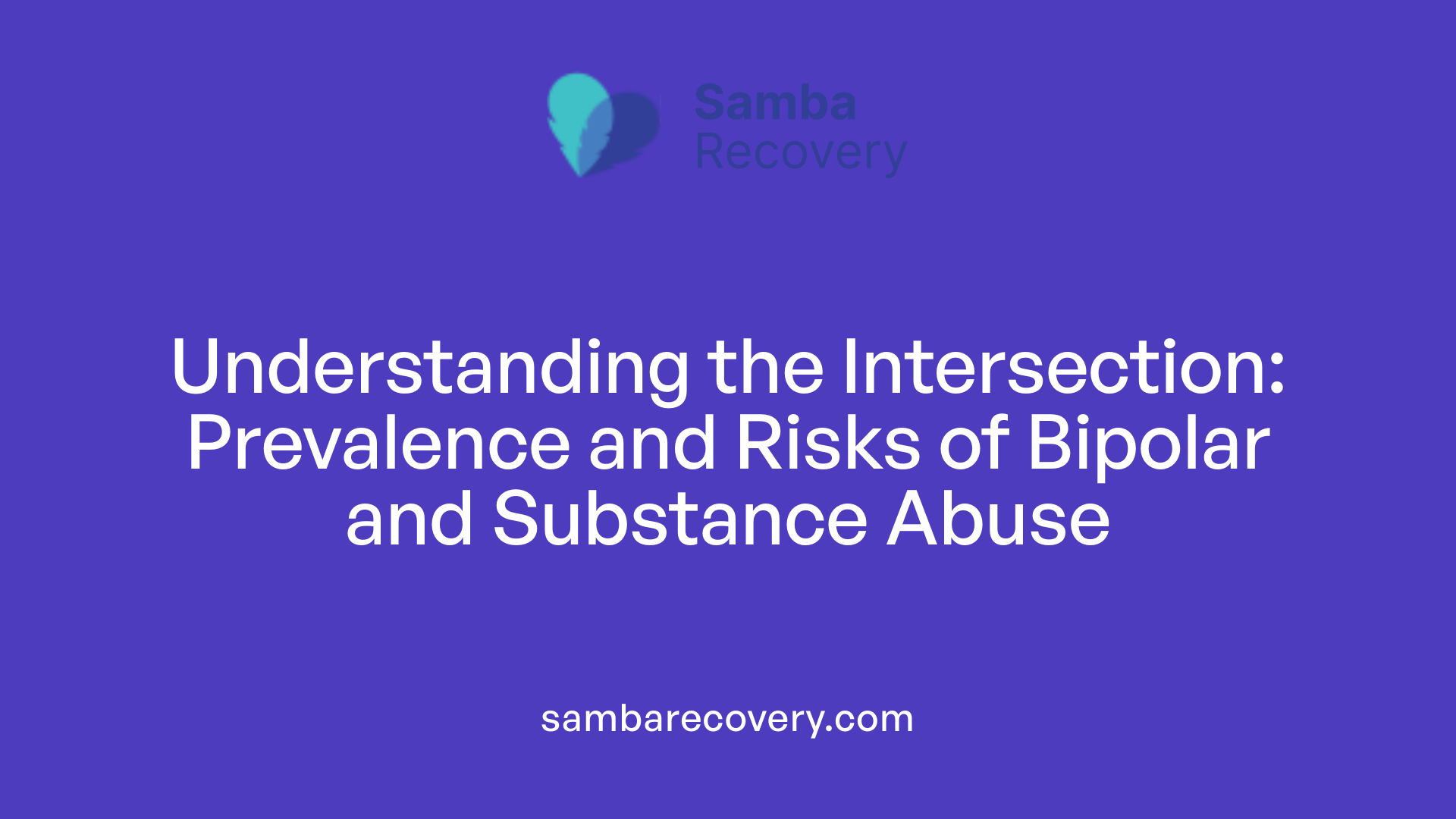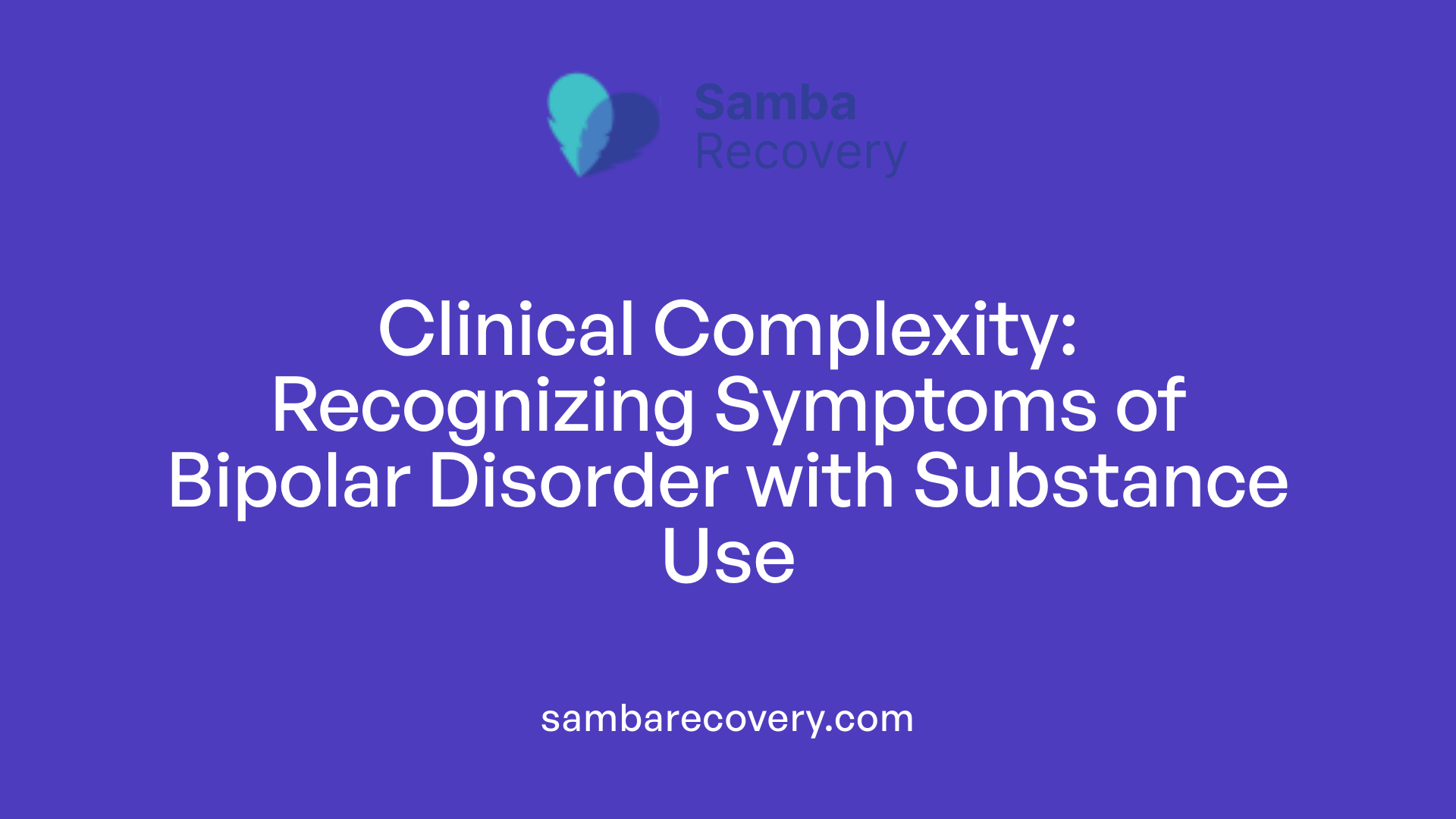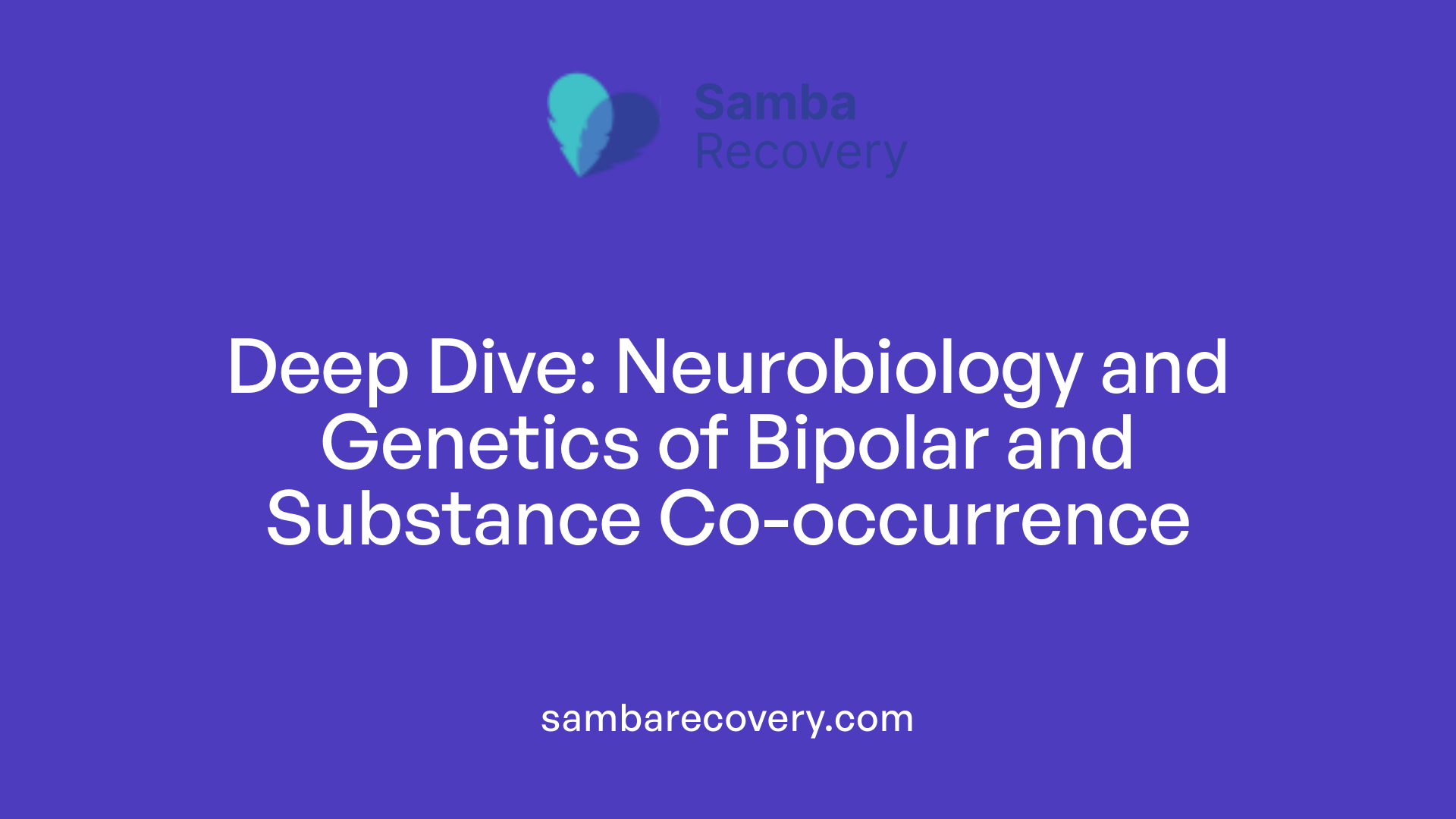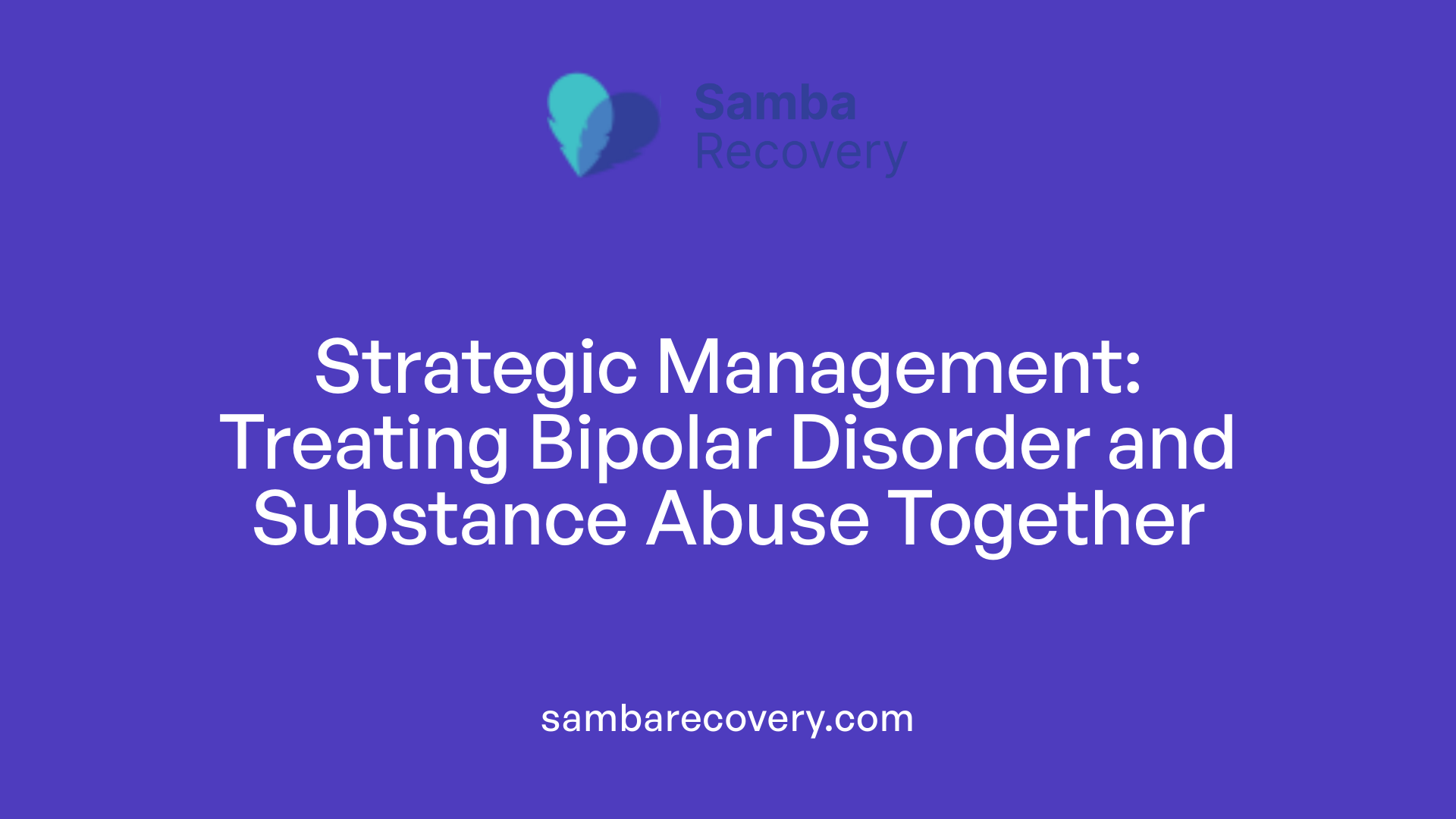Understanding the Bidirectional Relationship
The coexistence of bipolar disorder and substance abuse represents a significant challenge within mental health. Research indicates that bipolar disorder most frequently co-occurs with alcohol and drug abuse, complicating diagnosis, worsening clinical outcomes, and requiring tailored treatment approaches. This article explores the intricate connection between these conditions, drawing on scientific data, epidemiological trends, symptomatology, and treatment strategies to shed light on this prevalent dual diagnosis.
Prevalence and Epidemiological Trends

What is known about the epidemiology and prevalence of bipolar disorder and substance abuse comorbidity?
Research consistently shows that co-occurring substance use disorders (SUD) and bipolar disorder (BD) are highly prevalent across different populations. Epidemiological surveys estimate that between 42% and 60% of individuals with bipolar disorder have experienced some form of substance abuse or dependence during their lifetime. Specifically, around 24% of people with BD have a history of alcohol use disorder, while approximately 17% struggle with illicit drug use disorders, including cannabis and stimulants.
Demographic differences also exist; males are generally more likely than females to experience comorbidity between bipolar disorder and SUDs. Those with this dual diagnosis tend to experience an earlier onset of symptoms, which often leads to more frequent hospitalizations and more severe psychosocial difficulties, such as impaired relationships and occupational challenges.
The association is particularly strong with certain substances like alcohol, cannabis, and cocaine. Odds ratios from various studies indicate that individuals with bipolar disorder are significantly more likely to use these substances than those without bipolar. For example, people with bipolar I disorder show a lifetime prevalence of substance use disorders reaching as high as 65%, and over half often have an alcohol use disorder.
Despite some differences between bipolar I and bipolar II, the overall rates of substance use comorbidities are similar, highlighting the widespread nature of this issue. This high prevalence poses substantial treatment challenges, emphasizing the need for integrated approaches that address both mood stabilization and substance use reduction.
What causes and risk factors are associated with co-occurring bipolar disorder and substance abuse?
Multiple interconnected factors contribute to the high rates of co-occurring bipolar disorder and substance abuse. Genetic predispositions play a significant role, as research indicates common genetic links that may increase vulnerability to both conditions. Family history of mental illness and substance use can elevate the risk, suggesting a hereditary component underlying their overlap.
Biological factors, such as neurochemical imbalances involving dopamine, serotonin, and norepinephrine, are central to both mood regulation and the reward pathways affected by drugs. Dysregulation of these neurotransmitters may predispose individuals to mood swings and addictive behaviors.
Environmental triggers are also influential. Stressful life events, sleep disruptions, seasonal changes, and major life stressors often precipitate episodes of bipolar disorder and increase impulsivity, which can lead to substance experimentation or addiction. Substance use itself can further disturb brain chemistry, creating a vicious cycle.
Behavioral traits such as impulsivity, poor judgment, and emotional dysregulation tend to be heightened during mood episodes, making substance misuse more likely as a form of self-medication. Medications like antidepressants or corticosteroids may even act as triggers for mood episodes, further complicating the clinical picture.
Altogether, these biological, genetic, and environmental factors form an intertwined network that fosters the development and persistence of comorbid bipolar disorder and SUDs, necessitating comprehensive treatment strategies.
Symptomatology and Clinical Features

What are the symptoms and clinical features of bipolar disorder when combined with substance use?
The co-occurrence of bipolar disorder and substance use presents a complex clinical picture marked by more intense and unpredictable mood episodes. Individuals often experience exacerbated manic or depressive states, which may be triggered or masked by the effects of substances such as alcohol, cannabis, or stimulants.
During manic episodes, symptoms may include hyperactivity, inflated self-confidence, decreased need for sleep, risky behaviors, and psychotic features like paranoia. Substance use can intensify these symptoms, leading to increased impulsivity and reckless behavior. In depressive episodes, symptoms might include hopelessness, fatigue, sleep disturbances, and suicidal ideation. Substances like alcohol or opioids can deepen depressive mood or mimic depression, complicating diagnosis.
The overlapping symptoms between bipolar episodes and substance effects pose significant diagnostic challenges. Substance use often leads to more recurrent episodes that are resistant to treatment, with a higher likelihood of hospitalization and suicidal attempts. Moreover, substances may temporarily alleviate mood symptoms, prompting self-medication which further muddles the clinical presentation.
Overall, the presence of substance use in bipolar patients can result in a more severe course of illness, with increased emotional volatility, psychosis risk, and risky behaviors. Recognizing these features requires careful assessment, including mood charts, psychological testing, and thorough evaluation of substance effects.
How does substance abuse influence bipolar symptoms and treatment outcomes?
Substance abuse plays a detrimental role in the trajectory of bipolar disorder by intensifying mood symptom severity and disrupting treatment efforts. Many substances abused, such as cocaine, marijuana, and alcohol, can mimic or worsen the symptoms of bipolar episodes. For example, alcohol often induces or mimics depressive symptoms, while stimulants like cocaine may trigger manic episodes.
The high prevalence of substance use disorder among bipolar patients—up to 60%—means that substance abuse is often intertwined with mood instability. This interaction can lead to faster relapse, longer episodes, and greater fluctuations between mood states. It also reduces treatment adherence, as substances interfere with the efficacy of mood-stabilizing medications such as lithium, anticonvulsants, or antipsychotics.
Furthermore, substance use increases the risk of poor clinical outcomes, including higher hospitalization rates, increased suicidality, and worse psychosocial functioning. Individuals may also develop tolerance or resistance to medications, making it harder to achieve symptom control.
Effective management requires an integrated treatment approach that simultaneously addresses both bipolar disorder and substance use. This includes pharmacotherapy aimed at mood stabilization, alongside psychosocial interventions such as cognitive-behavioral therapy, motivational interviewing, and comprehensive relapse prevention strategies.
In summary, substance abuse exacerbates bipolar symptoms and complicates treatment, demanding coordinated care plans and ongoing monitoring to improve patient outcomes.
Neurobiological and Genetic Underpinnings

What scientific research exists on the coexistence of bipolar disorder and substance abuse?
Extensive scientific studies have confirmed that bipolar disorder often co-occurs with substance use disorders (SUD), with lifetime comorbidity rates reaching approximately 56%. This strong association stems from complex biological, genetic, and environmental interactions.
Research indicates that shared neurobiological mechanisms play a crucial role. For example, dysregulation of neurotransmitter systems such as dopamine and gamma-aminobutyric acid (GABA) is common in both conditions. These neurochemical alterations affect how the brain processes reward, mood regulation, impulsivity, and motivation.
Environmental factors such as stress, trauma, and early substance exposure further increase the risk of developing both bipolar disorder and SUD. Comorbidity is associated with more severe clinical outcomes — including increased frequency and intensity of mood episodes, higher rates of hospitalization, treatment resistance, and elevated risks for violence and suicide.
Scientific literature emphasizes that integrated treatment approaches, combining medication and psychosocial therapies, are critical for improving outcomes. Despite these insights, high-quality clinical trials remain limited, underscoring the need for ongoing research.
Overall, understanding the neurobiological and genetic foundations of bipolar disorder with substance abuse highlights the importance of accurate diagnosis and comprehensive care strategies to enhance prognosis.
How do substances influence brain chemistry related to bipolar disorder?
Substances like alcohol, cannabis, cocaine, and opioids profoundly impact brain chemistry, especially targeting the brain’s reward pathways. These substances hijack the system involving dopamine, a key neurotransmitter responsible for feelings of pleasure, reward, and motivation.
Chronic use results in neuroadaptations—permanent or semi-permanent changes in neurotransmitter activity—that exacerbate mood dysregulation. For instance, excessive dopamine release during drug use creates intense euphoria but also leads to diminished natural dopamine function over time.
Alterations in other critical neurotransmitters such as serotonin and norepinephrine—which are central to mood stabilization—are also common. These disruptions can trigger or intensify mood episodes characteristic of bipolar disorder, such as manic, hypomanic, or depressive states.
Neurobiological studies further reveal structural and functional changes in brain regions like the prefrontal cortex and limbic system. Dysfunction in these areas impairs judgment, impulse control, and emotional regulation, which are often compromised in individuals with comorbid bipolar disorder and substance abuse.
The impact of substances thus creates a vicious cycle, aggravating symptoms and reducing the effectiveness of conventional mood-stabilizing medications—a significant challenge in treatment.
Are there shared genetic factors contributing to both bipolar disorder and substance abuse?
Genetics play a significant role in the development of both bipolar disorder and substance use disorders. Studies of twins and families demonstrate that these conditions often run in families, suggesting common inherited vulnerabilities.
Current research points to specific genes involved in neurotransmitter regulation—particularly those affecting dopamine, serotonin, and norepinephrine pathways—as potential shared genetic factors. Variations in these genes may predispose individuals to mood dysregulation and addictive behaviors.
While identifying precise genetic markers remains an ongoing process, evidence supports a biological overlap. This overlap helps explain why many individuals with bipolar disorder are more susceptible to initiating or developing substance use problems.
Additionally, environmental influences—such as childhood trauma, stress, and early drug exposure—interact with genetic predispositions, further elevating the risk.
Understanding these shared hereditary factors emphasizes the importance of family-based assessments and personalized treatment plans aimed at addressing both bipolar disorder and substance abuse. Continued genetic research aims to uncover specific targets for preventive interventions and customized therapies, ultimately improving outcomes for individuals with these intertwined conditions.
Impact on Treatment and Management Strategies

How does substance abuse impact bipolar disorder and vice versa?
Substance abuse can significantly worsen the course of bipolar disorder by increasing the frequency, severity, and duration of mood episodes. It often hampers ongoing treatment adherence, making disease management more challenging. Common substances abused by individuals with bipolar disorder include alcohol, cannabis, cocaine, and opioids. These substances can mimic or intensify mania and depression, leading to more complex clinical presentations.
Conversely, bipolar disorder often predisposes individuals to substance use as a form of self-medication. People may turn to alcohol or drugs to cope with mood swings, stress, or intense emotional distress. This bidirectional relationship creates a cycle where each condition exacerbates the other.
Epidemiological data reveal that up to 60% of those with bipolar disorder have a history of substance abuse. Such comorbidities are linked to poorer treatment results, including higher relapse rates, increased hospitalizations, and a greater risk of suicidal behaviors. Addressing this involves integrated, multidisciplinary treatment plans that concurrently target both mood stabilization and substance reduction.
What are the treatment and management options for co-occurring bipolar and substance use disorders?
Managing co-occurring bipolar disorder and substance use disorder requires an integrated approach where both conditions are treated simultaneously, rather than one after the other. This approach enhances the likelihood of sustained recovery and minimizes relapse.
Key elements include forming a strong therapeutic alliance that fosters motivation and engagement. Psychotherapeutic interventions such as cognitive-behavioral therapy (CBT), motivational interviewing, and relapse prevention strategies are vital. These therapies help patients recognize triggers, develop coping strategies, and build resilience against substance use.
Pharmacological treatments are tailored to stabilize mood and reduce cravings. Mood stabilizers like lithium or valproate are commonly prescribed. To directly address substance dependence, medications such as naltrexone or acamprosate may be used.
Ongoing monitoring and regular assessments facilitate early detection of symptoms recurrence or relapse cues. Coordinated care across mental health, addiction services, and social support programs ensures comprehensive management.
Support groups, lifestyle modifications, and addressing comorbid medical conditions play essential roles in maintaining long-term recovery. The overall goal is to improve mood stability, reduce substance use, and enhance psychosocial functioning, thereby leading to better quality of life.
| Treatment Component | Description | Additional Details |
|---|---|---|
| Pharmacotherapy | Mood stabilizers, craving reducers | Lithium, valproate, naltrexone |
| Psychotherapeutic Interventions | Therapy approaches to address behaviors | CBT, motivational interviewing, relapse prevention |
| Support and Lifestyle Changes | Peer support, lifestyle adjustments | Support groups, healthy routines, family therapy |
| Monitoring and Follow-up | Regular assessment and care adjustments | Ongoing evaluations, early relapse detection |
Additional Considerations
Proper diagnosis can be challenging due to symptom overlap, especially during intoxication or withdrawal phases. Therefore, continuous assessment, including psychological testing, mood charts, and medical history review, is essential.
Despite limited high-quality clinical trial data specifically for bipolar and SUD co-treatment, evidence suggests that integrated treatment strategies yield better outcomes than treating each disorder separately. This requires collaboration across healthcare disciplines, ensuring that medication management aligns with psychosocial interventions.
Overall, a comprehensive, personalized approach offers the best chance for recovery, emphasizing the importance of early intervention and sustained support systems.
Challenges in Diagnosis and Clinical Management

How is bipolar disorder diagnosed and assessed when co-occurring with substance abuse?
Diagnosing bipolar disorder in the context of substance use presents significant challenges due to overlapping symptoms. Mental health professionals rely on a comprehensive evaluation process that includes detailed clinical interviews to explore the history and characteristics of mood episodes, assessing their severity, duration, and impact on daily functioning.
Standardized screening tools are integral to this process. These include instruments such as the Mood Disorder Questionnaire (MDQ), the Hypomania Checklist (HCL-33), the Alcohol Use Disorders Identification Test (AUDIT), and the Drug Abuse Screening Test (DAST). These tools help clinicians identify symptoms of mood disturbances and substance use patterns.
A critical aspect of assessment is distinguishing primary bipolar disorder from mood changes induced by substance use. To do this, clinicians often require a period of abstinence from substances to observe if mood symptoms persist independently. The temporal relationship between substance use and mood episodes is also scrutinized, along with family and personal mental health histories.
Because substance abuse can temporarily alter mood and behavior, clinicians incorporate collateral information from family members or close contacts to verify symptom history. Mood charts or diaries might be used to document fluctuations over time. An accurate diagnosis typically involves a multidimensional approach, synthesizing clinical observations, self-reports, and objective data to inform tailored treatment plans. This meticulous process aims to ensure that both mental health and substance use conditions are appropriately addressed for effective management.
What are the risks of overdiagnosis and misdiagnosis in patients with substance use?
The diagnostic process for bipolar disorder in individuals with substance use problems is complicated by the risk of overdiagnosis. Many substances—such as alcohol, cannabis, stimulants, and prescription medications—can cause mood swings, irritability, or behavioral changes that resemble bipolar symptoms.
This symptom overlap increases the likelihood of misdiagnosing substance-induced mood episodes as primary bipolar disorder. Such misdiagnosis can lead to inappropriate treatment approaches, including unnecessary medication prescriptions for bipolar disorder, without addressing the underlying substance use issues. Consequences include ineffective symptom management, medication side effects, and increased risk of relapse.
Furthermore, overdiagnosis can divert attention from treating the core substance use disorder, delaying recovery and increasing the likelihood of chronic illness. It may also result in patients being labeled with a mental health disorder when their mood symptoms are solely attributable to substance effects.
Clinicians mitigate these risks by conducting thorough assessments that include observing symptoms during periods of abstinence, gathering collateral historical information, and employing a cautious, stepwise diagnostic approach. Recognizing the intricate interplay between substances and mood is crucial for accurate diagnosis, appropriate treatment planning, and improving long-term outcomes.
Integrated Treatment Modalities and Future Directions
What treatment strategies and management options are effective for co-occurring bipolar disorder and substance abuse?
Treating individuals with both bipolar disorder and substance use disorder (SUD) requires a comprehensive, integrated approach that concurrently addresses both conditions. Such strategies are generally more effective than sequential or separate treatments.
A cornerstone of successful management is fostering a strong therapeutic alliance based on empathy, understanding, and motivation. This relationship encourages patient engagement and adherence to treatment plans.
Psychotherapy plays a vital role, with cognitive-behavioral therapy (CBT) helping patients recognize and modify thought patterns that contribute to mood episodes and substance cravings. Motivational interviewing enhances motivation for change and supports sustained abstinence.
Relapse prevention techniques and psychoeducation help patients understand their mood and behavior patterns, reducing the likelihood of relapse.
Pharmacological treatments include mood stabilizers like lithium and valproate, which help control mood swings and may reduce substance cravings. Medications such as naltrexone are used to diminish the reinforcing effects of alcohol and opioids.
Continuous monitoring is essential for early detection of mood episodes or relapse into substance abuse. Ongoing assessments enable healthcare providers to adjust treatments as needed.
Collaborative, multidisciplinary care involving psychiatrists, addiction specialists, therapists, and primary care providers ensures a holistic approach.
Support groups and lifestyle modifications, such as regular exercise and sleep hygiene, contribute to long-term stability.
Addressing co-occurring conditions and social determinants—like housing stability, employment, and social support—further supports recovery and improves overall outcomes.
What are the gaps in current research on bipolar disorder and substance abuse, and what future directions are promising?
Despite advances, significant gaps remain in understanding and effectively managing co-occurring bipolar disorder and SUD. Most notably, there is a shortage of large-scale, high-quality clinical trials that evaluate the efficacy of pharmacological and therapeutic interventions specifically tailored for dual diagnosis populations.
Current research lacks definitive evidence on the long-term benefits of existing medications for dual diagnosis, and often these treatments are adapted from single-condition studies with limited validation.
Further, personalized medicine approaches based on genetic, neurobiological, and psychosocial factors are still in early development. This precision medicine could enable tailored treatments that maximize efficacy and minimize adverse effects.
Emerging therapies, including transcranial magnetic stimulation (TMS), ketamine infusions, cognitive remediation strategies, digital therapeutics, and immunomodulatory treatments, show promise but require thorough investigation through rigorous trials.
Future research should focus on understanding shared neurobiological pathways, which could lead to novel interventions targeting common underlying mechanisms.
Early intervention strategies to identify and treat bipolar disorder and SUD before severe episodes or dependence develop are crucial.
Developing integrated care models that combine mental health and addiction services can improve treatment adherence and patient outcomes.
Fostering collaboration among psychiatric, neurologic, and addiction specialists will enhance research, facilitate comprehensive care, and accelerate the development of innovative treatments.
Overall, advancing personalized, multidisciplinary approaches and exploring novel therapies are promising directions that could significantly improve management and outcomes for individuals with bipolar disorder and substance use disorders.
Towards Better Outcomes
The complex relationship between bipolar disorder and substance abuse necessitates a nuanced understanding and integrated treatment strategies. Early diagnosis, individualized care plans, and multidisciplinary approaches improve prognosis and reduce the risks of relapse, hospitalization, and suicide. Ongoing research into the neurobiological underpinnings and innovative therapies holds promise for more effective management in the future. Public health initiatives, educational resources, and family support systems play critical roles in addressing this pervasive dual diagnosis, ultimately guiding individuals toward recovery and stability. Continued efforts to bridge gaps in knowledge and practice are essential for transforming outcomes for millions affected worldwide.
References
- The relationship between substance abuse and bipolar disorder
- Bipolar Disorder And Addiction
- Bipolar Disorder and Comorbid Use of Illicit Substances – PMC
- The Most Effective Treatment for Severe Bipolar Disorder & Addiction
- Treating Bipolar Disorder and Substance Abuse: 5 Things to Know
- Bipolar Disorder and Substance Use – Partnership to End Addiction
- The Relationship Between Bipolar Disorder and Substance Abuse
- Understanding Bipolar Disorder and Substance Abuse
- Can Drug Addiction Cause Bipolar Disorder? | RACNJ






